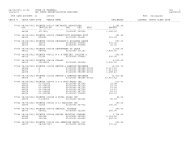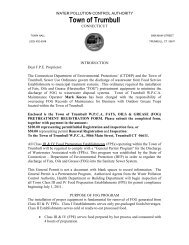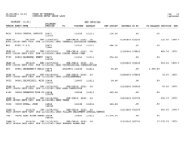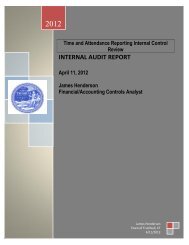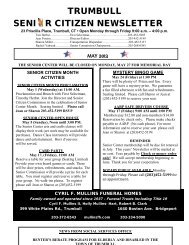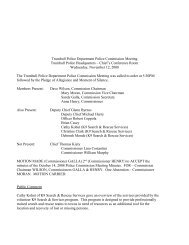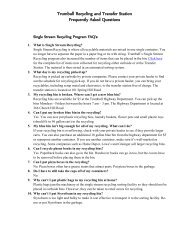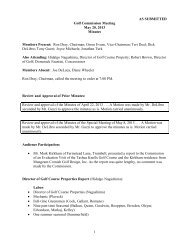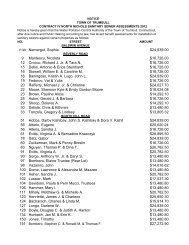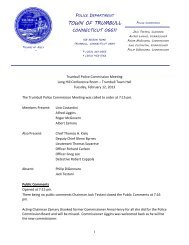Forensic Audit Report-WPCA Phase IV, Part B. Contract ... - Trumbull
Forensic Audit Report-WPCA Phase IV, Part B. Contract ... - Trumbull
Forensic Audit Report-WPCA Phase IV, Part B. Contract ... - Trumbull
You also want an ePaper? Increase the reach of your titles
YUMPU automatically turns print PDFs into web optimized ePapers that Google loves.
<strong>Forensic</strong> Consulting Services <strong>Report</strong><br />
Town of <strong>Trumbull</strong>, Connecticut<br />
Page 32<br />
Another example of leniency relates to the provisions or requirements set forth for “Blasting” under<br />
the Section 8 of the Supplemental General Conditions, which states:<br />
“If blasting is required, the <strong>Contract</strong>or shall supply the services of a “Seismic Consultant”<br />
who will perform pre and post blasting building conditions surveys and conduct seismic<br />
and over pressure measurements during blasting.”<br />
Based on available records and the interview process, it appears there is little if any documentation<br />
available to confirm as to whether or not an independent and qualified “Seismic Consultant” was<br />
employed by the contractor, whether monitoring of the blasting operations were indeed performed,<br />
or whether or not the data requirements of this Section (i.e. Pre and Post surveys, blast monitoring<br />
reports, etc.) were ever submitted by the contractor to the Town. The recollection of the field<br />
operations appear to indicate that this requirement of the <strong>Contract</strong> was not performed.<br />
Other examples of leniency, or items that may not have been performed, provided and/or levels of<br />
compliance were found to be lacking in performance or documentation whether the responsibilities<br />
of the Town or contractor, or both in accordance with the <strong>Contract</strong>, include the following:<br />
Section 5 of the General Conditions entitled “Shop Drawings”<br />
Section 14 of the General Conditions entitled “Negotiation of <strong>Contract</strong> Amendments”<br />
Section 2 of the Supplemental General Conditions entitled “Project Photographs”<br />
Section 5 of the Supplemental General Conditions entitled “Job Offices”<br />
Section 6 of the Supplemental General Conditions entitled “As-Built Records”<br />
Section 12 of the Supplemental General Conditions entitled “Sequence of Operations”<br />
Section 27 of the Supplemental General Conditions entitled “Sediment Control Measures”<br />
Specification Division 2, Section 2.5 entitled “Trench Excavation and Backfill”<br />
Field Records and Related Documentation<br />
A review of the Town’s field records and related documentation for <strong>Contract</strong> 3, or lack thereof, was<br />
found to be a major concern and proved to be a significant detriment in reviewing, reconstructing<br />
and, to any reliable sense, confirming the construction activities and the quantities for payment<br />
related to <strong>Contract</strong> 3. Typically one of the most important responsibilities given to a field<br />
representative inspecting a project of this type, or for any construction related activity, is to visually<br />
observe and fully document any and all onsite activities, conditions, events and other relevant<br />
matters in a detailed manner for accountability and future reference. This type of recordkeeping is<br />
typically done in writing utilizing standardized formats that are setup and established prior to<br />
construction. Primarily this recordkeeping should consist of a combination of daily/weekly field<br />
reports, diaries, quantity logs with material slips as applicable, field survey books, material shop<br />
drawings, test reports, as-built drawing markups, correspondence and memorandums of record, as<br />
well as being supplemented by photographic documents as deemed necessary. This is especially<br />
true when such inspection is being provided on a full-time basis. Upon completion all reporting<br />
documents should be maintained in a properly organized, centralized filing system that may be used<br />
by the Town for future reference.



